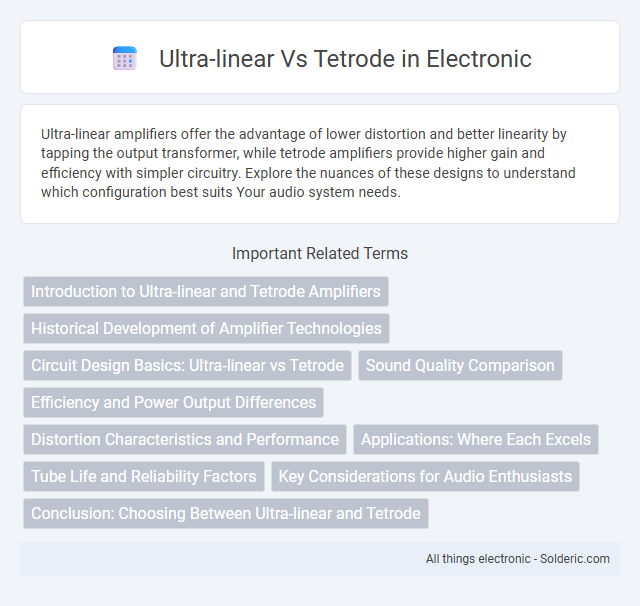Ultra-linear amplifiers offer the advantage of lower distortion and better linearity by tapping the output transformer, while tetrode amplifiers provide higher gain and efficiency with simpler circuitry. Explore the nuances of these designs to understand which configuration best suits Your audio system needs.
Comparison Table
| Feature | Ultra-linear | Tetrode |
|---|---|---|
| Definition | A pentode operating in triode mode using a tap on the output transformer. | A vacuum tube with four active electrodes: cathode, anode, control grid, and screen grid. |
| Output Quality | Lower distortion, improved linearity compared to standard pentodes. | Higher gain but more distortion than ultra-linear configuration. |
| Efficiency | Moderate efficiency, balances power and sound quality. | Higher efficiency due to stronger electron control. |
| Typical Use | High-fidelity audio amplifiers demanding low distortion. | Power amplification where gain is a priority over sound purity. |
| Transformer Configuration | Uses tapped output transformer to feed screen grid. | Uses direct screen grid voltage supply. |
| Distortion Levels | Typically 2-5% Total Harmonic Distortion (THD). | Typically 5-10% THD or higher. |
| Load Impedance | Lower output impedance, typically 5k-10k ohms. | Higher output impedance, typically 10k-20k ohms. |
| Historical Context | Popularized by David Hafler in 1950s for quality audio amplification. | Commonly used in early tube amplifiers for increased gain. |
Introduction to Ultra-linear and Tetrode Amplifiers
Ultra-linear and tetrode amplifiers are vital in high-fidelity audio systems, each offering distinct operational modes that influence sound quality and amplifier efficiency. Ultra-linear amplifiers utilize a tap on the output transformer's primary winding to drive screen grids, resulting in reduced distortion and improved linearity. Tetrode amplifiers, on the other hand, operate by applying a separate voltage to the screen grid, providing higher gain and power output but typically with more harmonic distortion compared to ultra-linear designs.
Historical Development of Amplifier Technologies
Ultra-linear and tetrode amplifier designs emerged during the mid-20th century, revolutionizing audio amplification by enhancing linearity and reducing distortion. The ultra-linear configuration, introduced by Alan Blumlein in the 1930s, combined features of triode and pentode operation, optimizing power output and sound quality. Tetrode amplifiers, developed earlier in the 1920s, offered improved gain and efficiency over triodes but suffered from higher distortion, which ultra-linear circuits addressed with innovative screen grid tapping techniques.
Circuit Design Basics: Ultra-linear vs Tetrode
Ultra-linear circuit design incorporates a screen grid connection between triode and pentode modes, enhancing linearity and reducing distortion compared to traditional tetrode circuits. Tetrode designs use a fixed screen grid voltage, offering higher gain but with increased distortion and less stability under varying load conditions. Your choice between ultra-linear and tetrode configurations significantly impacts audio performance, circuit complexity, and harmonic response in amplifier designs.
Sound Quality Comparison
Ultra-linear amplifiers deliver a balanced sound with enhanced clarity and reduced distortion, providing a more natural and transparent audio experience. Tetrode amplifiers produce a warmer, richer tone with stronger midrange emphasis but may introduce higher harmonic distortion. Audiophiles often prefer ultra-linear configurations for accurate reproduction, while tetrode designs appeal to those seeking a vintage, characterful sound.
Efficiency and Power Output Differences
Ultra-linear amplifier configurations typically offer higher efficiency by blending triode and pentode characteristics, resulting in lower distortion and improved linearity. Tetrode amplifiers generally provide greater power output due to their distinct screen grid design but sacrifice some efficiency and sound purity. Your choice depends on whether you prioritize smoother audio reproduction or maximum power delivery.
Distortion Characteristics and Performance
Ultra-linear amplifiers exhibit significantly lower harmonic distortion compared to tetrode designs, resulting in cleaner audio reproduction and improved linearity. Tetrode configurations tend to produce higher levels of second and third harmonic distortion, which can color the sound but may be preferred in specific musical contexts for their warmth. Your choice depends on whether you prioritize precise, low-distortion performance (ultra-linear) or a more characterful, harmonically rich output (tetrode).
Applications: Where Each Excels
Ultra-linear amplifiers excel in high-fidelity audio applications, delivering lower distortion and smoother sound reproduction ideal for audiophiles and studio settings. Tetrode amplifiers are preferred in high-power RF transmitters and broadcast equipment due to their robust output power and efficiency in handling high voltages. You can choose ultra-linear designs for critical listening environments, while tetrode configurations are better suited for industrial and communication uses.
Tube Life and Reliability Factors
Ultra-linear amplifier configurations typically extend tube life by operating tubes in a more linear region, reducing distortion and stress compared to tetrode modes. Tetrode operation runs tubes at higher voltages and currents, increasing heat dissipation and accelerating wear, which can shorten tube lifespan. Reliability factors favor ultra-linear setups due to lower thermal strain and improved stability, making them preferable for longer-term use.
Key Considerations for Audio Enthusiasts
Ultra-linear and tetrode configurations are critical for audio enthusiasts seeking optimal sound quality and amplifier performance. Ultra-linear design blends characteristics of both triode and tetrode modes, offering lower distortion and improved linearity, which enhances the audio clarity and dynamics. Tetrode operation tends to deliver higher power output but can introduce more distortion, making ultra-linear preferred for balanced, high-fidelity sound reproduction in hi-fi audio systems.
Conclusion: Choosing Between Ultra-linear and Tetrode
Choosing between ultra-linear and tetrode configurations depends on your desired balance of power output, distortion, and tonal characteristics. Ultra-linear designs offer lower distortion and smoother sound with moderate power efficiency, making them ideal for listeners seeking clarity and warmth. Tetrode operation delivers higher power and punchier dynamics but may produce more distortion, suiting those who prioritize raw power and a more aggressive tone.
Ultra-linear vs Tetrode Infographic

 solderic.com
solderic.com